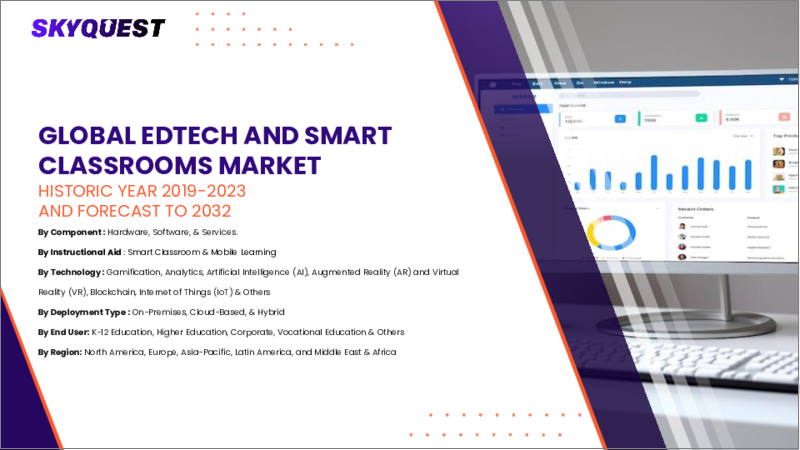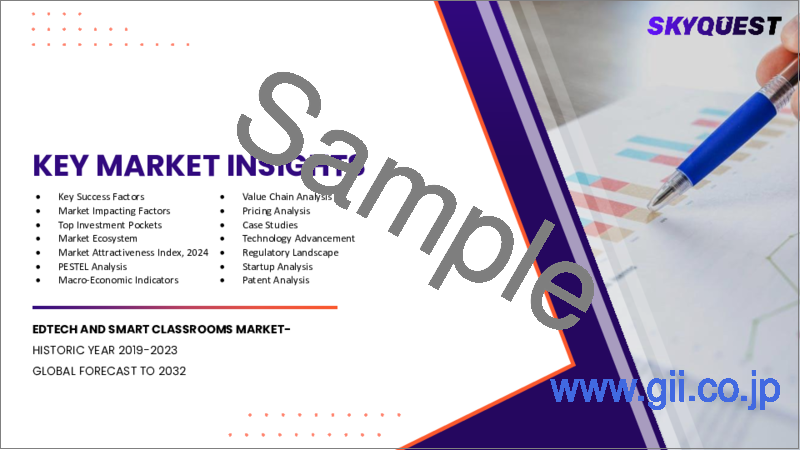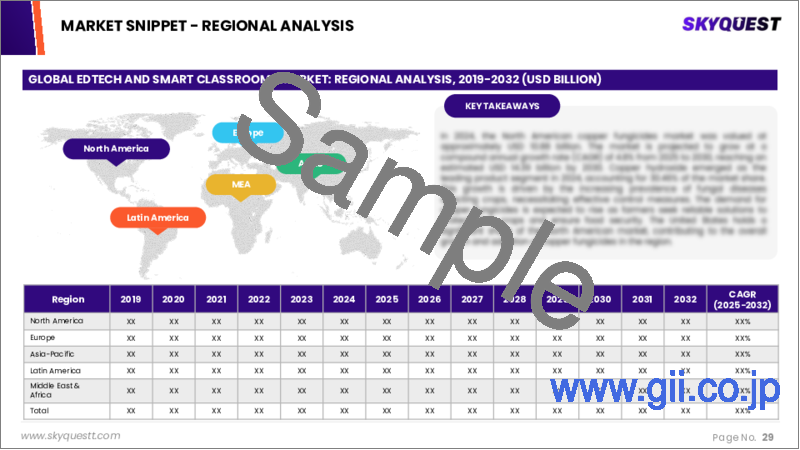|
|
市場調査レポート
商品コード
1629037
EdTechとスマート教室の市場規模、シェア、成長分析、コンポーネント別、展開タイプ別、エンドユーザー別、テクノロジー別、地域別 - 産業予測、2025~2032年EdTech and Smart Classrooms Market Size, Share, Growth Analysis, By Component (Hardware, Software), By Deployment Type (On-Premises, Cloud-Based), By End-User, By Technology, By Region - Industry Forecast 2025-2032 |
||||||
|
|||||||
| EdTechとスマート教室の市場規模、シェア、成長分析、コンポーネント別、展開タイプ別、エンドユーザー別、テクノロジー別、地域別 - 産業予測、2025~2032年 |
|
出版日: 2025年01月07日
発行: SkyQuest
ページ情報: 英文 356 Pages
納期: 3~5営業日
|
全表示
- 概要
- 目次
EdTechとスマート教室の世界市場規模は、2023年に1,335億5,000万米ドルとなり、予測期間(2025年~2032年)のCAGRは16.4%で、2024年の1,554億5,000万米ドルから2032年には5,238億7,000万米ドルに成長する見通しです。
科学的学習を活用してトレーニング効率を高めるEdTech分野は、大きな成長機会とともに急速に進化しています。高度な技術システムと多様な教育ツールを備えたスマート教室は、現代の教育環境に不可欠なものとなりつつあります。HolonIQによると、デジタルインフラは世界の教育支出のわずか3%に過ぎないが、デジタル変革の可能性は2031年までに10兆米ドルに急増すると予測されています。この急増は、スマート・クラスルーム・ソリューションと教育技術の採用が拡大していることを示しています。Articulate社の企業研修向け15億米ドル、BYJU社の幼稚園児から高校生までのプログラム向け4億6,000万米ドルなど、最近の資金調達の動向は、スキル開発の新興企業への投資の増加を浮き彫りにしています。この動向は、今後の教育市場の大幅な成長を促進すると予想されます。
目次
イントロダクション
- 調査の目的
- 調査範囲
- 定義
調査手法
- 情報調達
- 二次データと一次データの方法
- 市場規模予測
- 市場の前提条件と制限
エグゼクティブサマリー
- 世界市場の見通し
- 供給と需要の動向分析
- セグメント別機会分析
市場力学と見通し
- 市場概要
- 市場規模
- 市場力学
- 促進要因と機会
- 抑制要因と課題
- ポーターの分析
主な市場の考察
- 重要成功要因
- 競合の程度
- 主な投資機会
- 市場エコシステム
- 市場の魅力指数(2024年)
- PESTEL分析
- マクロ経済指標
- バリューチェーン分析
- 価格分析
- ケーススタディ
- 技術の進歩
- 規制情勢
- スタートアップ分析
- 特許分析
EdTechとスマート教室市場規模:コンポーネント別
- 市場概要
- ハードウェア
- インタラクティブディスプレイ
- インタラクティブプロジェクター
- インタラクティブホワイトボード
- その他
- ソフトウェア
- 学習管理システム(LMS)
- 学生情報システム(SIS)
- 教室管理ソフトウェア
- 言語学習ソフトウェア
- その他
- サービス
- 専門能力開発
- マネージドサービス
- サポートとメンテナンス
EdTechとスマート教室市場規模:展開タイプ別
- 市場概要
- オンプレミス
- クラウドベース
EdTechとスマート教室市場規模:エンドユーザー別
- 市場概要
- K-12教育
- 高等教育
- 企業
- 政府
EdTechとスマート教室市場規模:技術別
- 市場概要
- ゲーミフィケーション
- 分析
- 人工知能(AI)
- 拡張現実(AR)と仮想現実(VR)
- ブロックチェーン
- モノのインターネット(IoT)
EdTechとスマート教室市場規模
- 北米
- 米国
- カナダ
- 欧州
- ドイツ
- スペイン
- フランス
- 英国
- イタリア
- その他欧州地域
- アジア太平洋地域
- 中国
- インド
- 日本
- 韓国
- その他アジア太平洋地域
- ラテンアメリカ
- ブラジル
- その他ラテンアメリカ地域
- 中東・アフリカ
- GCC諸国
- 南アフリカ
- その他中東・アフリカ
競合情報
- 上位5社の比較
- 主要企業の市場ポジショニング(2024年)
- 主な市場企業が採用した戦略
- 市場の最近の動向
- 企業の市場シェア分析(2024年)
- 主要企業の企業プロファイル
- 会社概要
- 製品ポートフォリオ分析
- セグメント別シェア分析
- 収益の前年比比較(2022-2024)
主要企業プロファイル
- Google for Education(USA)
- Microsoft Education(USA)
- Apple Inc.(USA)
- IBM Corporation(USA)
- Dell Technologies(USA)
- HP Inc.(USA)
- Lenovo Group Limited(China)
- Samsung Electronics Co., Ltd.(South Korea)
- Adobe Inc.(USA)
- Blackboard Inc.(USA)
- Pearson PLC(UK)
- Instructure, Inc.(USA)
- D2L Corporation(Canada)
- Fujitsu Limited(Japan)
- Panasonic Corporation(Japan)
- Cisco Systems, Inc.(USA)
- Oracle Corporation(USA)
- Amazon Web Services(USA)
結論と推奨事項
Global EdTech and Smart Classrooms Market size was valued at USD 133.55 billion in 2023 and is poised to grow from USD 155.45 billion in 2024 to USD 523.87 billion by 2032, growing at a CAGR of 16.4% during the forecast period (2025-2032).
The EdTech sector, leveraging scientific learning to enhance training efficiency, is rapidly evolving with significant opportunities for growth. Smart classrooms, equipped with advanced technology systems and diverse teaching tools, are becoming essential for modern educational environments. According to HolonIQ, digital infrastructure represents only 3% of global education spending, yet the potential for digital transformation is projected to soar to USD 10 trillion by 2031. This surge indicates a greater adoption of smart classroom solutions and educational technology. The influx of funding in recent years-such as Articulate's USD 1.5 billion for corporate training and BYJU's USD 460 million for K-12 programs-highlights the increasing investment in skill development startups. This trend is expected to drive substantial growth in the education market moving forward.
Top-down and bottom-up approaches were used to estimate and validate the size of the Global Edtech And Smart Classrooms market and to estimate the size of various other dependent submarkets. The research methodology used to estimate the market size includes the following details: The key players in the market were identified through secondary research, and their market shares in the respective regions were determined through primary and secondary research. This entire procedure includes the study of the annual and financial reports of the top market players and extensive interviews for key insights from industry leaders such as CEOs, VPs, directors, and marketing executives. All percentage shares split, and breakdowns were determined using secondary sources and verified through Primary sources. All possible parameters that affect the markets covered in this research study have been accounted for, viewed in extensive detail, verified through primary research, and analyzed to get the final quantitative and qualitative data.
Global Edtech And Smart Classrooms Market Segmental Analysis
Global EdTech and Smart Classrooms Market is segmented by Component, Deployment Type, End-User, Technology and region. Based on Component, the market is segmented into Hardware, Software and Services. Based on Deployment Type, the market is segmented into On-Premises and Cloud-Based. Based on End-User, the market is segmented into K-12 Education, Higher Education, Corporate and Government. Based on Technology, the market is segmented into Gamification, Analytics, Artificial Intelligence (AI), Augmented Reality (AR) and Virtual Reality (VR), Blockchain and Internet of Things (IoT). Based on region, the market is segmented into North America, Europe, Asia Pacific, Latin America and Middle East & Africa.
Driver of the Global Edtech And Smart Classrooms Market
The Global EdTech and Smart Classrooms market is witnessing significant growth driven by several key factors. The increasing availability of high-speed internet and extensive online learning resources plays a crucial role in this expansion. The surge in the education sector can be attributed to the widespread adoption of mobile devices and the affordability of e-learning tools. Regions such as Europe and the United States are leading in mobile and internet penetration, while emerging markets are expected to experience substantial growth, utilizing mobile technology as a primary means for knowledge acquisition. Consequently, the market is poised for rapid development in the near future.
Restraints in the Global Edtech And Smart Classrooms Market
The Global EdTech and Smart Classrooms market faces significant restraints due to high infrastructure costs and a shortage of technical expertise, both of which hinder its expansion. The financial burden associated with essential components of smart classroom setups-such as computers, projectors, tablets, and various specialized software-can be prohibitive for educational institutions. Additionally, schools may incur further expenses by needing to hire technology specialists to manage ongoing software updates and system modifications. As a result, these elevated costs pose considerable challenges to the widespread adoption and implementation of smart classroom solutions in the educational sector.
Market Trends of the Global Edtech And Smart Classrooms Market
The Global Edtech and Smart Classrooms market is increasingly embracing immersive technologies such as virtual reality (VR) and augmented reality (AR) to enhance educational experiences. This trend reflects a growing demand for innovative learning solutions that engage students actively, providing them with experiential learning opportunities that traditional methods may lack. By stimulating multiple senses, immersive learning environments significantly enhance comprehension and retention. AR enriches real-world perspectives, while VR creates fully immersive simulations, facilitating interactive lessons like virtual museum tours or science experiments. As educational institutions prioritize student engagement and effective learning outcomes, the integration of immersive technologies is poised to revolutionize classrooms worldwide.
Table of Contents
Introduction
- Objectives of the Study
- Scope of the Report
- Definitions
Research Methodology
- Information Procurement
- Secondary & Primary Data Methods
- Market Size Estimation
- Market Assumptions & Limitations
Executive Summary
- Global Market Outlook
- Supply & Demand Trend Analysis
- Segmental Opportunity Analysis
Market Dynamics & Outlook
- Market Overview
- Market Size
- Market Dynamics
- Drivers & Opportunities
- Restraints & Challenges
- Porters Analysis
- Competitive rivalry
- Threat of substitute
- Bargaining power of buyers
- Threat of new entrants
- Bargaining power of suppliers
Key Market Insights
- Key Success Factors
- Degree of Competition
- Top Investment Pockets
- Market Ecosystem
- Market Attractiveness Index, 2024
- PESTEL Analysis
- Macro-Economic Indicators
- Value Chain Analysis
- Pricing Analysis
- Case Studies
- Technology Advancement
- Regulatory Landscape
- Startup Analysis
- Patent Analysis
Global EdTech and Smart Classrooms Market Size by Component & CAGR (2025-2032)
- Market Overview
- Hardware
- Interactive Displays
- Interactive Projectors
- Interactive Whiteboards
- Other
- Software
- Learning Management Systems (LMS)
- Student Information Systems (SIS)
- Classroom Management Software
- Language Learning Software
- Other
- Services
- Professional Development
- Managed Services
- Support and Maintenance
Global EdTech and Smart Classrooms Market Size by Deployment Type & CAGR (2025-2032)
- Market Overview
- On-Premises
- Cloud-Based
Global EdTech and Smart Classrooms Market Size by End-User & CAGR (2025-2032)
- Market Overview
- K-12 Education
- Higher Education
- Corporate
- Government
Global EdTech and Smart Classrooms Market Size by Technology & CAGR (2025-2032)
- Market Overview
- Gamification
- Analytics
- Artificial Intelligence (AI)
- Augmented Reality (AR) and Virtual Reality (VR)
- Blockchain
- Internet of Things (IoT)
Global EdTech and Smart Classrooms Market Size & CAGR (2025-2032)
- North America (Component, Deployment Type, End-User, Technology)
- US
- Canada
- Europe (Component, Deployment Type, End-User, Technology)
- Germany
- Spain
- France
- UK
- Italy
- Rest of Europe
- Asia Pacific (Component, Deployment Type, End-User, Technology)
- China
- India
- Japan
- South Korea
- Rest of Asia-Pacific
- Latin America (Component, Deployment Type, End-User, Technology)
- Brazil
- Rest of Latin America
- Middle East & Africa (Component, Deployment Type, End-User, Technology)
- GCC Countries
- South Africa
- Rest of Middle East & Africa
Competitive Intelligence
- Top 5 Player Comparison
- Market Positioning of Key Players, 2024
- Strategies Adopted by Key Market Players
- Recent Developments in the Market
- Company Market Share Analysis, 2024
- Company Profiles of All Key Players
- Company Details
- Product Portfolio Analysis
- Company's Segmental Share Analysis
- Revenue Y-O-Y Comparison (2022-2024)
Key Company Profiles
- Google for Education (USA)
- Company Overview
- Business Segment Overview
- Financial Updates
- Key Developments
- Microsoft Education (USA)
- Company Overview
- Business Segment Overview
- Financial Updates
- Key Developments
- Apple Inc. (USA)
- Company Overview
- Business Segment Overview
- Financial Updates
- Key Developments
- IBM Corporation (USA)
- Company Overview
- Business Segment Overview
- Financial Updates
- Key Developments
- Dell Technologies (USA)
- Company Overview
- Business Segment Overview
- Financial Updates
- Key Developments
- HP Inc. (USA)
- Company Overview
- Business Segment Overview
- Financial Updates
- Key Developments
- Lenovo Group Limited (China)
- Company Overview
- Business Segment Overview
- Financial Updates
- Key Developments
- Samsung Electronics Co., Ltd. (South Korea)
- Company Overview
- Business Segment Overview
- Financial Updates
- Key Developments
- Adobe Inc. (USA)
- Company Overview
- Business Segment Overview
- Financial Updates
- Key Developments
- Blackboard Inc. (USA)
- Company Overview
- Business Segment Overview
- Financial Updates
- Key Developments
- Pearson PLC (UK)
- Company Overview
- Business Segment Overview
- Financial Updates
- Key Developments
- Instructure, Inc. (USA)
- Company Overview
- Business Segment Overview
- Financial Updates
- Key Developments
- D2L Corporation (Canada)
- Company Overview
- Business Segment Overview
- Financial Updates
- Key Developments
- Fujitsu Limited (Japan)
- Company Overview
- Business Segment Overview
- Financial Updates
- Key Developments
- Panasonic Corporation (Japan)
- Company Overview
- Business Segment Overview
- Financial Updates
- Key Developments
- Cisco Systems, Inc. (USA)
- Company Overview
- Business Segment Overview
- Financial Updates
- Key Developments
- Oracle Corporation (USA)
- Company Overview
- Business Segment Overview
- Financial Updates
- Key Developments
- Amazon Web Services (USA)
- Company Overview
- Business Segment Overview
- Financial Updates
- Key Developments





